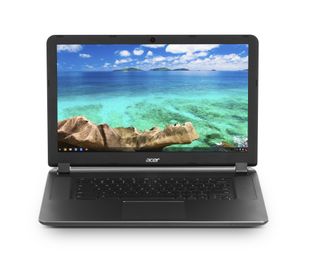Acer's Low Price Jamboree: New Chromebook 15, Aspire R 11, Aspire ES 11 All Under $250
Acer announced new devices up and down virtually its entire product stack today in New York City, including a plethora of laptops and laptop replacements. Acer is typically a value-oriented brand, and indeed, several of its new products slip in under the $250 mark. These include a new Chromebook, a convertible notebook and an entry-level laptop.
Acer has several Chromebooks in its quiver already, and today's announcement of the $199 Chromebook 15 CB3-531 helps round out the bottom of its pricing range.

The company's newly-announced Aspire R11 is a smallish (11.6-inch display) convertible notebook capable of four different "modes" (clamshell, pad, display and tent) made possible by a 360-degree hinge. In a press release, Acer boasted of the dual-torque hinge. "The hinge has a dual-torque design which allows it to easily open, while at the same time, it applies extra torque which stabilizes the panel and reduces wobble when the screen is touched."

The audio channel can automatically adjust based on the screen orientation, and Acer promised excellent audio quality with the Aspire R11's TrueHarmony audio technology, which offers strength and flexibility along with a wider bass range.
The Aspire 11 also features BluelightShield, a technology designed to reduce eye strain due to blue light screen emissions. Acer designed the Aspire 11's Precision Touchpad to mimic "gestures and behaviors consistent with those of a touchscreen, such as pinch-to-zoom, swipe, and scroll."
Base configurations of the Aspire 11 will cost just $249 -- which is none too shabby for a convertible.
At its NYC event, Acer announced a slew of new notebooks, but one stands out because of its low price. For a starting price of just $229, you can nab yourself an Acer Aspire ES 11 notebook.
Stay on the Cutting Edge
Join the experts who read Tom's Hardware for the inside track on enthusiast PC tech news — and have for over 25 years. We'll send breaking news and in-depth reviews of CPUs, GPUs, AI, maker hardware and more straight to your inbox.

The Aspire ES 11 has the same TrueHarmony, BluelightShield and Precision Touchpad features as the Aspire 11, and it's also an 11.6-inch device that runs on an Intel Celeron chip. You can also opt for an optical drive.
Here's a helpful spec comparison:
| Header Cell - Column 0 | Acer Chromebook 15 (CB3-531) | Acer Aspire R11 (R3-131T) | Acer Aspire ES 11 (ES-131) |
|---|---|---|---|
| Processor | Intel Celeron N2830 (Bay Trail) | Intel Pentium (base)Intel Celeron | Intel Pentium (base)Intel Celeron |
| Graphics | Intel HD Graphics | Intel HD Graphics | Intel HD Graphics |
| Display | 15.6-inch (1366x768) | 11.6-inch (1366x768), Corning Gorilla Glass, Zero Air Gap | 11.6-inch (1366x768*) |
| RAM | 2 GB | 8 GB DDR3L | 8 GB |
| Storage | 16 GB eMMC | 500 GB HDD (base), up to 1 TB HDD | up to 500 GB HDD |
| Camera | webcam, HDR | Acer Crystal Eye HD webcam | VGA webcam |
| Connectivity | -MIMO 2x2 802.11ac-Bluetooth 4.0 | MIMO 2x2 802.11ac* | Unknown |
| Ports | USB 3.0, USB 2.0, HDMI, SD/SDXC (128 GB) | USB 3.0, USB 2.0, HDMI, VGA, SD card reader | Unknown |
| Battery | 11.5 hrs | 8 hrs | 5.5 hrs |
| Platform | Chrome OS | Windows 8.1 | Windows 8.1 |
| Price | $199.99 | $249 | $229 |
| Availability | July 2015 | July 2015 | July 2015 |
| Type | Chromebook | Convertible | Clamshell |
*This appears to be the case, but we have been yet unable to confirm.
All three of these devices offer a low-price alternative to better-spec'd and -featured products in their respective stacks. They are decidedly low-powered, to be sure, but Acer's idea here is to provide "essential" performance for those on a budget.
One could argue that Acer has been cagey about investing in one type of platform versus another; it some ways, products such as the trio mentioned above actually compete with one another. At least, that's how Google and Microsoft would likely see it, as they're in a struggle for the lower end of the laptop/laptop replacement market. And it is true that Chromebooks and cheap Windows notebooks are fighting over many of the same customers.
But Acer would say (and has said) that it's simply offering the widest array of products possible to serve as many different customer needs as possible. So if you want a mobile productivity device, and don't want to spend a lot of scratch, Acer has plenty of options on a variety of platforms.
And that fact alone is a big deal; times have changed. I distinctly recall when I was broke and in graduate school and found myself frantically pressing the power button on my suddenly-dead laptop. I didn't need that much out of a PC, but the cheapest replacement I could find at the time that served my needs ended up costing me just under $1,000.
That was a grand that I did not have. You could argue that these sub-$250 devices still aren't very powerful, and maybe some of them are junk (we couldn't say either way without first testing them ourselves). But they most definitely lower the cost of entry for throngs of computer users, and that is a very good thing.
Seth Colaner is the News Director for Tom's Hardware. Follow Seth Colaner @SethColaner. Follow us @tomshardware, on Facebook and on Google+.
Most Popular

